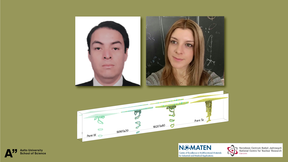Physics Double Research Seminar: Javier Dominguez & Silvia Bonfanti (NOMATEN, Poland)

When
Where
Event language(s)
Welcome to join us for a double research seminar by Javier Dominguez and Silvia Bonfanti of NOMATEN (National Centre for Nuclear Research, Poland)!
The seminars will last approximately 20 mins each, followed by questions. Coffee, tea and snacks will be served- please remember to bring your own cup to reduce waste!
Hosts: Profs. Andrea Sand and Mikko Alava
Title (J. Dominguez): Composition-dependent plastic deformation in W-Ta alloys through machine-learned nanoindentation simulations
Abstract: In this study, we perform large-scale machine learned molecular dynamics simulations to investigate the influence of tantalum concentrations on the incipient plasticity mechanisms of crystalline tungsten matrices during room temperature nanoindentation. The tabulated Gaussian approximation potential (TabGap) framework is applied to describe W-Ta interactions [1]. We focus on (001), (011), and (111) orientations to tracking the nucleation and interaction of dislocations where results for pure tungsten predict the nucleation of twins at two different locations on the {112}<111> family, one pointing downward and the other slightly inclined with respect to the {111} indented surface orientation. These twinning systems also become active for tungsten-tantalum alloys where compositional effects are taken into account, but the downward-pointing system becomes more predominant exhibiting defect nucleation. Our results suggest that surface energy is a key variable in the detwinning process, with higher surface energy leading to twin instability and breakdown into dislocations. However, a more detailed analysis reveals that the detwinning processes in the slightly inclined system of the W surfaces (TabGap) are as pronounced as those modeled with the Ravelo potential for Ta in the same twinning system [2,3]. On the other hand, twin annihilation in the vertical system is more facilitated in W TabGap compared to Ta TabGap. This suggests that the onset of W-Ta alloys approaches the marked twin annihilation observed in pure tungsten. Our findings indicate that a complete twin nucleation criterion should consider other components of the stress tensor in addition to resolved shear stress. These findings have implications for the design of next-generation fusion machines that rely on refractory BCC metals and their alloys.
[1] J. Byggmästar, K. Nordlund, F. Djurabekova. Phys. Rev. Mat. 6, 083801 (2022)
[2] J. Varillas, J. Očenášek, Jordi Torner et al. Acta Materialia 125 , 431 (2017)
[3] F. Dominguez-Gutierrez, P. Grigorev, et al. Phys. Rev. Materials 7, 043603 (2023)
Bio: Javier Dominguez completed his PhD in Computational Physics with Summa Cum Laude at the National University of Mexico (UNAM). During his doctoral studies, he joined Prof. Krstic's group in Stony Brook University focusing on the study of plasma-material interactions in tokamak plasmas in collaboration with the Princeton Plasma Physics Laboratory. Prior to his current position, Javier was awarded the A. von Humboldt Research Fellowship at the Max Planck Institute for Plasma Physics in Germany. During this fellowship, he developed a machine learning-based software workflow called FAVAD for the characterization and visualization of defects in damaged solids under the supervision of Dr. Udo von Toussaint. This software was the winner of the IAEA challenge in 2019. Currently, Javier serves as an assistant professor in the group of Prof. Mikko Alava in NOMATEN CoE, Poland. His research involves the development of numerical models and molecular dynamics techniques to explore the nano-mechanical response of single crystal materials and high entropy metal alloys. The aim is to design materials suitable for fusion and industrial applications. This work is carried out in collaboration with theoretical and experimental scientists from research institutes in the USA and EU. Dr. Dominguez has obtained habilitation at the national laboratory for nuclear research and has a publication record with over 40 scientific publications in the fields of materials for extreme operating conditions, 2D materials for electronic devices and catalysis, and mechanics of materials.
Title (S. Bonfanti): Simulated metallic glasses akin to experiments
Abstract: In this study we employ a novel numerical methodology that combines Monte Carlo and molecular dynamics simulations to study ultra-stable metallic glasses, specifically the Cu46Zr46Al8 system. This unique hybrid approach allows us to generate for the first time in simulations equilibrated samples at temperatures below the standard glass transition, as defined by conventional techniques, thus faithfully reproducing experimental conditions. The investigations shed light on the kinetics, thermodynamics and rheology within the ultra-stable glassy regime. Our results show a pronounced increase in brittleness in the mechanical response of ultra-stable glasses. This research effectively bridges the gap between simulations and physical experiments, offering valuable implications for the understanding and processing of metallic glasses.
Bio: Dr. Silvia Bonfanti is a physicist who has conducted extensive research in fields such as glasses, metamaterials, and materials science. Her approach is marked by the use of interdisciplinary methodologies, including theoretical studies, numerical simulations, optimization algorithms, and machine learning techniques.
Among her key accomplishments is her work on computational methods to design mechanical metamaterials, which has been published in Nature Communications and resulted in an industrial patent filed in both the EU and the US.
Currently an Assistant Professor at NOMATEN, Poland, Dr. Bonfanti's research focuses on high entropy alloys in both their crystalline and glassy forms. Her multidisciplinary perspective enables her to explore their unique properties, furthering the understanding of these complex materials.
- Published:
- Updated: